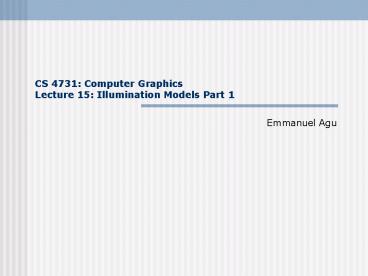CS 4731: Computer Graphics Lecture 15: Illumination Models Part 1 - PowerPoint PPT Presentation
Title:
CS 4731: Computer Graphics Lecture 15: Illumination Models Part 1
Description:
CS 4731: Computer Graphics Lecture 15: Illumination Models Part 1 Emmanuel Agu Announcements Midterm Return on Monday Scores will be on myWPI over the weekend Project ... – PowerPoint PPT presentation
Number of Views:91
Avg rating:3.0/5.0
Title: CS 4731: Computer Graphics Lecture 15: Illumination Models Part 1
1
CS 4731 Computer GraphicsLecture 15
Illumination Models Part 1
- Emmanuel Agu
2
Announcements
- Midterm
- Return on Monday
- Scores will be on myWPI over the weekend
- Project 4
- On class website later today
- Due next Friday
3
Illumination and Shading
4
Illumination and Shading
- Problem Model light/surface points interaction
to determine final color and brightness
lighting
5
Shading
- Apply the lighting model at a set of points
across the entire surface
Shading
6
Illumination Model
- The governing principles for computing the
illumination - A illumination model usually considers
- Light attributes (intensity, color, position,
direction, shape) - Object surface attributes (color, reflectivity,
transparency, etc) - Interaction among lights and objects
7
Basic Light Sources
Light intensity can be independent or dependent
of the distance between object and the light
source
Point light
Directional light
Area light
Spot light
8
Local Illumination
- Local illumination only consider the light, the
observer position, and the object material
properties - OpenGL does this
9
Global Illumination
- Global illumination take into account the
interaction of light from all the surfaces in the
scene - Example Ray tracing
10
Simple Local Illumination
- The model used by OpenGL
- Consider three types of light contribution to
compute the final illumination of an object - Ambient
- Diffuse
- Specular
- Final illumination of a point (vertex)
- ambient diffuse specular
11
Ambient Light Contribution
- Ambient light background light
- Light that is scattered by the environment
- Frequently assumed to be constant
- Very simple approximation of global illumination
- No direction independent of light position,
object orientation, observers position or
orientation
object 4
object 3
object 2
object 1
12
Ambient Light Example
13
Ambient Light Calculation
- Each light source has ambient light contribution
(Ia) - Different objects can reflect different amounts
of ambient - Different ambient reflection coefficients Ka, 0
lt Ka lt 1 - So, ambient light from an object is
- Ambient Ia x Ka
14
Diffuse Light Contribution
- Diffuse light The illumination that a surface
receives from a light source and reflects equally
in all direction
It does not matter where the eye is
15
Diffuse Lighting Example
16
Diffuse Light Calculation
- Need to decide how much light the object point
receive from the light source based on
Lamberts Law
Receive less light
Receive more light
17
Diffuse Light Calculation
- Lamberts law the radiant energy D that a small
surface patch receives from a light source is - D I x cos (q)
- I light intensity
- q angle between the light vector and the
surface normal
light vector (vector from object to light)
q
N surface normal
18
Diffuse Light Calculation
- Like ambient case, different objects reflect
different amount of diffuse light - different diffuse reflection coefficient Kd, (0
lt Kd lt 1) - So, the amount of diffuse light that can be seen
is - Diffuse Kd x I x cos (q)
cos(q) N.L
19
Specular light contribution
- The bright spot on the object
- The result of total reflection of
- the incident light in a concentrate
- region
See lots specular
See no specular
20
Specular light example
21
Specular light calculation
- How much reflection you can see depends on where
you are
Only position the eye can see specular from P if
object has an ideal reflection surface
But for non-perfect surface you will still see
specular highlight when you move a little bit
away from the idea reflection direction When f
is small, you see more specular highlight
22
Specular light calculation
- Phong lighting model
- specular Ks x I x cos(f)
- Ka specular reflection coefficient
- N surface normal at P
- I light intensity
- V vector from P to viewers eye
- R mirror-reflection direction
- f angle between V and R
- cos(f) the larger is n, the smaller
- is the cos value
- cos(q) R.V
n
n
23
Specular light calculation
- The effect of n in the phong model
n 10
n 90
n 30
n 270
24
Put it all together
- Illumination from a light
- Illum ambient diffuse specular
- Ka x I Kd x I x (N.L) Ks x
I x (R.V) - If there are N lights
- Total illumination for a point P S
(Illum) - Some more terms to be added (in OpenGL)
- Self emission
- Global ambient
- Light distance attenuation and spot light effect
n
25
References
- Hill, chapter 8

















![Real-Time Volume Graphics [07] Global Volume Illumination PowerPoint PPT Presentation](https://s3.amazonaws.com/images.powershow.com/7513877.th0.jpg?_=20160105118)













